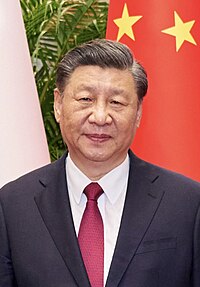
Photo from wikipedia
A total of 106 24-h PM2.5 aerosol samples were collected in an urban area (Shijiazhuang, SJZ) and a suburban area (Liulihe, LLH, Fangshan County, Beijing) in the Beijing-Tianjin-Hebei (BTH) region… Click to show full abstract
A total of 106 24-h PM2.5 aerosol samples were collected in an urban area (Shijiazhuang, SJZ) and a suburban area (Liulihe, LLH, Fangshan County, Beijing) in the Beijing-Tianjin-Hebei (BTH) region in 2 periods: the first is from 10 July to 10 August, which is before Sept. Third Parade (Period I); the second is from 20 Aug. to 6 Sept. 2015, which is during Sept. Third Parade (Period II). Polar organic tracers, including isoprene, α-pinene, β-caryophyllene and toluene oxidation products, as well as sugars and carboxylic acids were measured. In Period II, rigorous emission-reduction measures were taken in the BTH region. With the anthropogenic emission being cut down significantly, the average concentrations of isoprene, α-pinene, β-caryophyllene and toluene oxidation products and all carboxylic acids (except tetradecanoic, palmitic, and stearic acids), were lower in Period II than those in Period I in LLH, indicating that the SOA tracers were decreased with precursor emission volumes and yields in the atmosphere. Moreover, sugar compounds were shown with comparable levels during the two periods in LLH, suggesting that no measures were taken to reduce the intensities of the biogenic sources. On the contrary, tetradecanoic, palmitic, and stearic acids were shown with obviously higher concentrations in Period II than those in Period I, demonstrating that cooking fumes increased during Sept. Third Parade period. The positive matrix factorization (PMF) model combining with tracer-based method was applied to explore the sources of secondary organic carbon (SOC). It reveals that the sources of SOC include isoprene, α-pinene, β-caryophyllene and toluene oxidation products, fossil fuel combustion, cooking fumes and regionally transferred aged aerosols. These sources accounted for 11.3%, 9.0%, 15.5%, 10.9%, 29.2%, 2.9%, 21.1% of SOC for SJZ, and 12.7%, 11.2%, 9.7%, 14.4%, 25.3%, 0%, 26.7% of SOC for LLH, during the whole sampling periods respectively.
Journal Title: Environmental pollution
Year Published: 2020
Link to full text (if available)
Share on Social Media: Sign Up to like & get
recommendations!